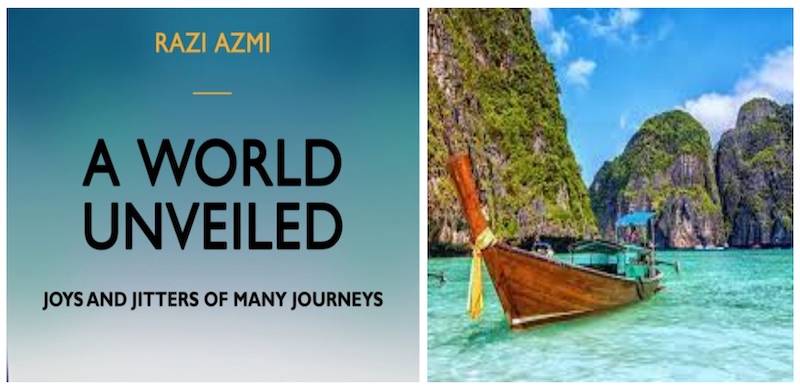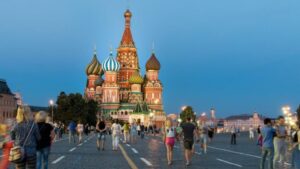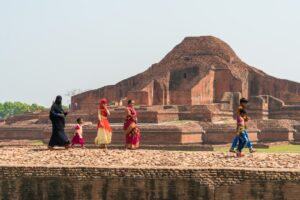
Razi Ami’s life as an academic has been overshadowed as a traveller, and a very ardent one. He is a traveller who would like to go wherever his urge takes him, not bothered by any obstacles -- rightly bitten by the ‘travel bug.’ This urge took him to the remote limits of northern Pakistan in his younger days, areas that were not easily accessible in those days.
The travelogue covers his travels across five continents, Asia, Africa and Europe (just Russia), North America and South America. Thus, while most travelogues focus on a particular region, this covers the whole globe. This is not a regular travelogue that is about travels, and has two additional aspects, it carries a social and political commentary, and the touch of a memoir. These are woven neatly into the narrative. He says, it is ‘essentially a personal account, a subjective reflection.’ (p.31)
The travels take the reader on incredible journeys, across faraway lands, remote corners of China, and Russia; through the Amazon region, the Andes mountains, Kalahari desert, Ferghana valley; and many more incredible places that have touristic value, places most people dream about. He has travelled mostly by road, and rail to get the maximum out of his touristic quest -- often caught in challenging situations.
After a brief introduction to travelling and tourism (useful for travellers), an African Journey takes the author across the length and breadth of a vast continent; he travels through Mauritius, Madagascar, Zimbabwe, Botswana, Namibia, Lesotho, S Africa, Mozambique, Ghana, Togo, Benin, Senegal, Mauritania, Gambia and Rwanda. The tourism part is supplemented with well-informed political commentary, especially in the case of Zimbabwe (under Mugabe), and Rwanda (on the deadly genocide). There is interesting trivia as well—a Ten Trillion banknote in Zimbabwe! One highlight of the visit is meeting ‘Grandma Obama’ in Kenya.

Then comes a journey through 5 Stans of Central Asia, mostly by road, on a scenic route, with an interesting account of their history and culture, including political dispensation. Another trivia, Uzbekistan as the world’s only ‘double landlocked country’.
Visit to Afghanistan is more interesting, somewhat adventurous, given the political situation there. Especially the visit to and through the Salang tunnel to Mazar Sharif, ‘in the news for the last three decades for all the wrong reasons’.
This is followed by an account of two trips to India, in 1991 and 2006, highlighting the giant railway system, besides the tourist attractions. He rightly observes that India has so much to see, in terms of both Muslim and Hindu cultures. His travels take him to Goa, Mysore, Bengalaru, Darjeeling, Varnasi, Jaipur, Trivandrum, Madurai, Chandigarh, besides other known and unknown places.
Comparisons with Pakistan are interesting. Another memorable visit is to Kanyakumari (Cape Comorin)—‘the southernmost point of the mainland South Asian subcontinent.’
Two trips are worth special attention: the rail-road trip from Xinjiang to Tibet is exciting; with a memorable visit to Lhasa and imposing Potala Palace at the roof of the world; and the train trip from Beijing to Moscow; an excerpt could send a chill up the readers (and the travellers) spine, ‘
‘We reached the Russian border post of Naushki in less than an hour. Here we were struck by the biting cold wind. Not only were we well and truly in Siberia, it seemed we were stranded as well…with Siberia to the north and Mongolia to the south, exactly 5850 km from Moscow and 1500 km from Beijing’ (p.152)—both journeys a tourists dream, the latter, ‘the trip of a lifetime.’
The political commentary, like on Africa, and Afghanistan, is well informed with some info based on research and observation on the land and region. These two aspects set this apart from other travelogues. There is a touch of nostalgia as well, as when the author visits his hometown in Bangladesh, formerly Pakistan's eastern wing, and visits the high school and the railway station, where his father was posted; similarly, visit to Columbus, Ohio, where he completed his graduate studies.
A meeting with Mr Z A Bhutto as a young student in Dacca adds another interesting bio touch. (Bhutto would soon be the President of Pakistan.)

Around 17,000 kms of travel, by car, across North America is comparatively smoother, with the usual stops through tourist attractions like the Grand Canyon, Niagara Falls, and non-touristic, like OSU, Ohio. There are usual comparisons, and a useful road travel tip, ‘most Canadians travelling to Calgary or Vancouver from Toronto or vice versa prefer to drive on the American side of the border, because the American roads are appreciably better….’ (p. 224)
Azmi rightly observes that South America is a continent little known to the south Asians, though they have a presence there. Journey through the vast continent is incredible, Brazil, Peru, Bolivia, Chile, Argentina, Uruguay. Sites such as Iguazu Falls, Machu Picchu, Cuzco, Lake Titicaca, Beagle Channel are all amazing, not to mention the amazing Amazon, and mighty Andes, and the southernmost spot of Puerto Williams. Trivia: La Paz as the world’s highest national capital; Navy in landlocked Bolivia!
While discussion of visit to Afghanistan gives the travelogue a touch of adventure, for some reason, visits to two countries, Iran and Turkey, are missed that are close by and would have complemented the travel through western and central Asia.
Azmi is a keen observer; he leaves home with homework neatly done. He not only enjoys what he sees, but analyses that with an academic mind, as a sociologist and a political scientist. The style keeps the reader riveted, and many parts read like an adventure narrative. Besides, the account carries a wealth of information, useful for a tourist as well as for a social science student. Text is usefully supplemented with maps and routes taken. One would like to see more of his travel accounts.
In the Postscript, the author highlights the ‘jitters’ and obstacles to free travel in different parts of the world. The conclusion is thought-provoking, more openness at borders, to promote more interaction among peoples and cultures. This is particularly true for south Asia (read India-Pakistan) where border crossing is a hassle while so many still have family ties on the other side. That the ‘Berlin Wall was not demolished in 1989 but rather moved from Central Europe to the Indo-Pakistan border’ (p.45) comes as a poignant observation.
On a personal note, it feels good to go through the account, having worked with Dr M R Azmi, at Quaid-e-Azam University, Islamabad, when such travels would have been on his mind, when such extensive travels would have been just a dream.
The travelogue covers his travels across five continents, Asia, Africa and Europe (just Russia), North America and South America. Thus, while most travelogues focus on a particular region, this covers the whole globe. This is not a regular travelogue that is about travels, and has two additional aspects, it carries a social and political commentary, and the touch of a memoir. These are woven neatly into the narrative. He says, it is ‘essentially a personal account, a subjective reflection.’ (p.31)
The travels take the reader on incredible journeys, across faraway lands, remote corners of China, and Russia; through the Amazon region, the Andes mountains, Kalahari desert, Ferghana valley; and many more incredible places that have touristic value, places most people dream about. He has travelled mostly by road, and rail to get the maximum out of his touristic quest -- often caught in challenging situations.
After a brief introduction to travelling and tourism (useful for travellers), an African Journey takes the author across the length and breadth of a vast continent; he travels through Mauritius, Madagascar, Zimbabwe, Botswana, Namibia, Lesotho, S Africa, Mozambique, Ghana, Togo, Benin, Senegal, Mauritania, Gambia and Rwanda. The tourism part is supplemented with well-informed political commentary, especially in the case of Zimbabwe (under Mugabe), and Rwanda (on the deadly genocide). There is interesting trivia as well—a Ten Trillion banknote in Zimbabwe! One highlight of the visit is meeting ‘Grandma Obama’ in Kenya.

Then comes a journey through 5 Stans of Central Asia, mostly by road, on a scenic route, with an interesting account of their history and culture, including political dispensation. Another trivia, Uzbekistan as the world’s only ‘double landlocked country’.
Visit to Afghanistan is more interesting, somewhat adventurous, given the political situation there. Especially the visit to and through the Salang tunnel to Mazar Sharif, ‘in the news for the last three decades for all the wrong reasons’.
Then comes a journey through 5 Stans of Central Asia, mostly by road, on a scenic route, with an interesting account of their history and culture, including political dispensation. Another trivia, Uzbekistan as the world’s only ‘double landlocked country’.
This is followed by an account of two trips to India, in 1991 and 2006, highlighting the giant railway system, besides the tourist attractions. He rightly observes that India has so much to see, in terms of both Muslim and Hindu cultures. His travels take him to Goa, Mysore, Bengalaru, Darjeeling, Varnasi, Jaipur, Trivandrum, Madurai, Chandigarh, besides other known and unknown places.
Comparisons with Pakistan are interesting. Another memorable visit is to Kanyakumari (Cape Comorin)—‘the southernmost point of the mainland South Asian subcontinent.’
Two trips are worth special attention: the rail-road trip from Xinjiang to Tibet is exciting; with a memorable visit to Lhasa and imposing Potala Palace at the roof of the world; and the train trip from Beijing to Moscow; an excerpt could send a chill up the readers (and the travellers) spine, ‘
‘We reached the Russian border post of Naushki in less than an hour. Here we were struck by the biting cold wind. Not only were we well and truly in Siberia, it seemed we were stranded as well…with Siberia to the north and Mongolia to the south, exactly 5850 km from Moscow and 1500 km from Beijing’ (p.152)—both journeys a tourists dream, the latter, ‘the trip of a lifetime.’
The political commentary, like on Africa, and Afghanistan, is well informed with some info based on research and observation on the land and region. These two aspects set this apart from other travelogues. There is a touch of nostalgia as well, as when the author visits his hometown in Bangladesh, formerly Pakistan's eastern wing, and visits the high school and the railway station, where his father was posted; similarly, visit to Columbus, Ohio, where he completed his graduate studies.
A meeting with Mr Z A Bhutto as a young student in Dacca adds another interesting bio touch. (Bhutto would soon be the President of Pakistan.)

Around 17,000 kms of travel, by car, across North America is comparatively smoother, with the usual stops through tourist attractions like the Grand Canyon, Niagara Falls, and non-touristic, like OSU, Ohio. There are usual comparisons, and a useful road travel tip, ‘most Canadians travelling to Calgary or Vancouver from Toronto or vice versa prefer to drive on the American side of the border, because the American roads are appreciably better….’ (p. 224)
Azmi rightly observes that South America is a continent little known to the south Asians, though they have a presence there. Journey through the vast continent is incredible, Brazil, Peru, Bolivia, Chile, Argentina, Uruguay. Sites such as Iguazu Falls, Machu Picchu, Cuzco, Lake Titicaca, Beagle Channel are all amazing, not to mention the amazing Amazon, and mighty Andes, and the southernmost spot of Puerto Williams. Trivia: La Paz as the world’s highest national capital; Navy in landlocked Bolivia!
While discussion of visit to Afghanistan gives the travelogue a touch of adventure, for some reason, visits to two countries, Iran and Turkey, are missed that are close by and would have complemented the travel through western and central Asia.
Azmi is a keen observer; he leaves home with homework neatly done. He not only enjoys what he sees, but analyses that with an academic mind, as a sociologist and a political scientist. The style keeps the reader riveted, and many parts read like an adventure narrative. Besides, the account carries a wealth of information, useful for a tourist as well as for a social science student. Text is usefully supplemented with maps and routes taken. One would like to see more of his travel accounts.
While discussion of visit to Afghanistan gives the travelogue a touch of adventure, for some reason, visits to two countries, Iran and Turkey, are missed that are close by and would have complemented the travel through western and central Asia.
In the Postscript, the author highlights the ‘jitters’ and obstacles to free travel in different parts of the world. The conclusion is thought-provoking, more openness at borders, to promote more interaction among peoples and cultures. This is particularly true for south Asia (read India-Pakistan) where border crossing is a hassle while so many still have family ties on the other side. That the ‘Berlin Wall was not demolished in 1989 but rather moved from Central Europe to the Indo-Pakistan border’ (p.45) comes as a poignant observation.
On a personal note, it feels good to go through the account, having worked with Dr M R Azmi, at Quaid-e-Azam University, Islamabad, when such travels would have been on his mind, when such extensive travels would have been just a dream.

